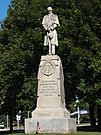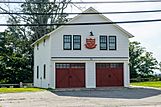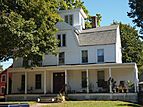Colchester Village Historic District facts for kids
Quick facts for kids |
|
|
Colchester Village Historic District
|
|

A sign in front of the Cragin library signals the start of the historic district
|
|
| Location | Roughly, along Broadway, Hayward, Linwood and Norwich Aves., Cragin Ct., Pierce Ln., Stebbins Rd., Main and S. Main Sts., Colchester, Connecticut |
|---|---|
| Area | 75 acres (30 ha) |
| Architect | Multiple |
| Architectural style | Greek Revival, Federal, Colonial |
| NRHP reference No. | 94000254 |
| Added to NRHP | April 4, 1994 |
The Colchester Village Historic District is a special area in Colchester, Connecticut. It includes most of the old village center. This historic district is where three main roads meet: Route 16, Route 85, and Norwich Avenue.
This area is important because it has many old buildings. It was officially added to the National Register of Historic Places in 1994. This means it's recognized for its historical value.
Contents
Exploring Colchester's Historic Center
The heart of the district is the Colchester Town Green. This open space is surrounded by many buildings. Most of these buildings were built in the 1800s. They include shops, homes, and public buildings.
Famous Buildings Around the Green
Two very important buildings stand out. One is the Colchester Federated Church. It was built in the Greek Revival style. This style uses ideas from ancient Greek temples.
The other is Bacon Academy. This school was built in 1803. It was one of the first high schools in the area. Bacon Academy is also listed as a separate historic place.
Across from the Green is the Hayward House. It was built way back in 1767! Today, it's a bed and breakfast. The Wheeler Block is another key building. It used to be the town hall.
A Look Back at Colchester's History
Colchester became a town in 1698. At first, it was a farming community. People lived spread out across the land. The village center grew around the town's first church and cemetery.
How the Village Grew
The village became important because it was a crossroads. Several main roads met here in the early 1800s. This made it a good place for trade and business.
Bacon Academy opened in 1803. It was the first secondary school in the region. Colchester was also home to the first Masonic lodge in the area. This group was founded in 1782.
In the late 1800s, small factories started up in the village. This led to more buildings being built. The Wheeler Block, for example, shows off the fancy Second Empire style of architecture from that time.





